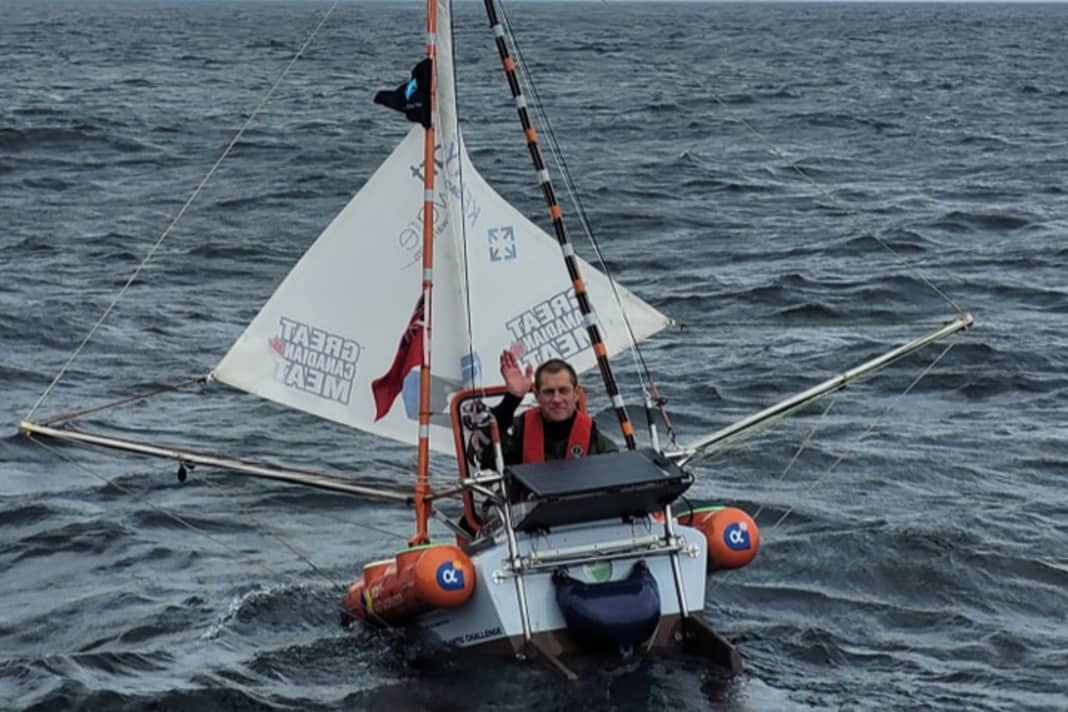After an accident in harbour: Andrew Bedwell plans new mini-yacht for Atlantic crossing






British sailor Andrew Bedwell wanted to attempt the 1,900 nautical mile crossing of the North Atlantic with the "Big C" and set a world record. The video shared on social media on 29 May, in which he explained that the micro-cruiser, which was just over a metre long, had crashed to the ground when it was uncraned and could no longer be saved, was correspondingly emotional.
The short clip showed the 49-year-old in tears, but no images or video footage of the incident or the destroyed "Big C". This has not changed to this day - Bedwell does not want to publish them and is thus creating a mystery. In his latest video, he explains that he did not take any photos so as not to put those involved out of a job. However, in it he also discusses the very unfortunate series of circumstances that ultimately led to the failure.
According to Bedwell: This was the reason for the water ingress on the "Big C"
Because when the record attempt with the microyacht was already underway and he was sailing on the Atlantic, the skipper noticed a water ingress despite numerous tests in advance and had himself towed back to the harbour. The boat lay there overnight and, according to Bedwell, was then craned out with over half a tonne of additional load due to the ingress of water. Initially, Bedwell said that the suspensions were broken because no straps could be placed under the hull. A written statement, however, states that the ropes from which the boat was suspended were broken.
But how could the water ingress even occur in such a project? Bedwell explains in a video that an important continuous bolt had to be replaced before the start. However, this work was carried out by his team, which is why he did not realise that the new one was threaded along its entire length. Nevertheless, he doesn't want to blame any of his team-mates: "It was my fault, I should have done it." According to Bedwell's theory, this allowed water to penetrate through the notches in the thread from below, even through seals. "I could have pumped the water out all the time, but I always said to my wife that I would turn back if I wasn't happy with something," he says, explaining the cancellation. Then followed the equally dramatic and mysterious events leading up to the end of "Big C".
In his emotional statement, Bedwell also left open how the project will continue. Many had cheered him up and offered comfort in the comments section, but others also interpreted the incident as a sign that it would be better not to attempt the crossing again for safety reasons. But less than a week after the supposed total loss of the first microyacht, Bedwell announced his intention to continue. A short time later, full of zest for action, he took his first measurements and made pencil sketches for the new build.
Plans for the new building- "My gut feeling told me that I should try aluminium this time."
This is because it is not supposed to be a copy of the first version, even though the skipper himself always presented it as technically flawless - apart from the faux pas during the record attempt. It is unclear why the 49-year-old adventurer now wants to break new ground. Bedwell had reckoned with speeds of up to 2.5 knots for the Atlantic crossing with the "Big C". One possible reason for the new approach could therefore be to improve the performance of the micro-cruiser based on the experience gained. The new record-breaking yacht is to have a significantly different design and be made of aluminium. When asked why he didn't want to stick with GRP, Bedwell replied in the Facebook comments: "My gut feeling told me to try aluminium this time."
In addition to the material and hull shape, the Brit is also aiming for a different concept for the keel. However, he does not yet know exactly which one. The new construction will therefore take some time, and a new start date is not yet known. The previous world record holder is the American Hugo Vihlen, who crossed the stormy North Atlantic in 1993 with a micro yacht that had a hull length of just 162 centimetres. Bedwell has set himself the goal of not simply setting a new record that will be beaten by a few centimetres at the next opportunity. His record is to be sailed to Great Britain for eternity.
In the YACHT interview before his first attempt, he talked about how he wants to eat, keep fit and sleep while travelling, among other things.
Andrew Bedwell explains the water ingress:
The emotional video after the end of "Big C":
At this point, you will find external content that complements the article. You can display and hide it with a click.

